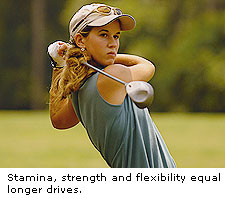Improved golf fitness helping LPGA stars raise the bar
 Watching the tournament rounds of today's LPGA players is more exciting than ever. Annika Sorenstam continues to dominate women's golf and shows where finesse, strength and athleticism come together to make way for the future.
Watching the tournament rounds of today's LPGA players is more exciting than ever. Annika Sorenstam continues to dominate women's golf and shows where finesse, strength and athleticism come together to make way for the future.
Is today's female golfer really that different? You need only look as far as statistics from previous years in combination with current levels of play to answer that question.
In 1998 - only seven short years ago - Sorenstam drove the ball 246 yards in average driving distance. Today, her average distance is 272 yards. Since undergoing a full-scale assault on fitness with the help of a personal trainer, she has gained nearly 30 yards in distance.
But is Sorenstam the lone ranger in women's golf or the wave of the future? Back in 1998, if a LPGA player drove the ball 250 yards, she was in the top 17 players in her field. Today, a player who drives the ball 250 yards won't even make the top 40.
So, what accounts for these new performance standards and how can female golfers around the country prepare for high level competition?
The most important aspects of the golf swing and the game, in general, all revolve around the building of a strong and solid foundation for the body, the mind and the basics of an athletic swing. Each of the following concepts plays a critical role in your understanding of what creates a great round of golf as well as contributes to lifetime enjoyment of the game.
Stamina
This is clearly the most under-estimated portion of the game. Golfers tend to ignore the cardiovascular component of golf. However, walkers cover an approximate walking distance of four to five miles each round. Even cart riders put in their fair share of walking, depending on local cart rules, weather conditions and following errant shots.
Poor cardiovascular conditioning can certainly have a negative impact on your game. In his book entitled "How I Play Golf" Tiger Woods said "fatigue can affect your focus and cause you to make a bad decision. I never want to lose a tournament because of a bad decision precipitated by my being out of shape."
Stability
The most important rule in a golf conditioning program is to work and develop strength from the core region of the body outward. A strong trunk allows forces to be transferred effectively from the legs to the upper body. It also enables the body to withstand those forces without breakdown.
Stabilization comes in many forms for the golfer including postural stabilization, trunk stabilization and joint stabilization. A strong and stable body allows the golfer to maintain the spine angle throughout the entire swing.
Strength
Strength comes in many forms with regard to the golf swing. Strong back muscles allow the golfer to endure the explosive movements in the swing. Strength in the trunk region or "core" area of the body produces stability and helps to generate power.
Combined muscle strength produces balance and coordination. Strong ligaments and tendons also prevent the joints from going beyond their range of motion. Physical strength often promotes mental acuity and toughness as a result.
Flexibility
Flexibility is the single most important physical characteristic likely to influence your golf swing. A tight body creates restricted motion in the swing and produces injuries as a form of compensation. Keep your body capable of moving through a full range of motion so it doesn't become a limiting factor in your performance. While women have a tendency towards ample flexibility, this isn't always the case.
Today's female golfer knows that hard work creates results and translates to a better position in the playing field. If you are looking for ways to take yourself to the top of the leader board, then place the needs of your body at the top of your priority list to make a definitive difference in your game.
Editor's note: Susan Hill is the President of Fitness for Golf, a Web site dedicated to helping golfers improve through golf-specific programs. She has earned national certifications as a fitness trainer with several organizations including the National Academy of Sports Medicine, the International Sports Science Association and the American Council on Exercise. She currently trains golfers of all levels at the Sunriver Resort in Sunriver, Ore.
As a Chek certified Golf Biomechanic and Sports Performance Nutritionist, Hill is now among an elite group of golf fitness experts nationwide. She has worked with hundreds of golfers ranging in skills from beginners just taking up the game of golf to collegiate, amateur and tour players looking for a more competitive edge.
Hill is a contributing writer to Golf Illustrated, a guest speaker at private and public golf clubs and a published writer on topics of health, fitness and golf. In 2003, she was named as one of the top three trainers of the year by the International Sport Science Association having been chosen from among more than 85,000 trainers worldwide. She is also a published author of a new book entitled "The Fitness Secrets of Championship Golfers."
April 12, 2005
Susan Hill is a fitness trainer, CHEK golf biomechanic and sports nutrition specialist. For on-line golf specific exercises and stretches, visit www.fitnessforgolf.com.
 By
By
Mafingei Nyamwanza wrote on: Jun 9, 2005
I am a 56 year old man a golfer and live in Zimbabwe. While on a visit to the UK and USA I read your article on balance. I tried the exercise on balance and was amazed at how difficult it is to stand in that posture with eyes closed. I could hold this position for a longer period than I could with my eyes closed. Why is this so and why is this exercise important for golf?
Mafingei.
Reply